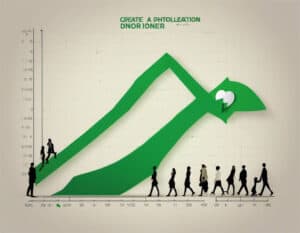What is the backbone of any successful nonprofit? Is it the high-flying marketing campaign or the all-star team? While these elements help, the real MVPs are your donors.
So, how do you go beyond the “donate now” button to form enduring relationships with these golden geese? In this guide, you’ll discover proven strategies for donor retention that will not only bolster your organization’s financial stability but also build a thriving community of loyal advocates.
1. Personalized Communication: Going Beyond “Dear Donor“
Personalized communication transcends generic messages, ensuring each donor feels acknowledged and valued as an individual.
Take a glance at Charity: Water. They send personalized emails, updating donors about the specific projects their contributions support. Such tailored touchpoints make donors feel directly connected to the impact they’re facilitating.
In fundraising, personalized communication is the linchpin to cultivating a deeper, more meaningful relationship with each donor.
Benefits of Personalized Communication
- Strengthens donor trust and loyalty.
- Increases chances of repeat donations.
- Enhances donor satisfaction and connection with the cause.
- Reduces donor attrition rates.
- Boosts overall engagement and advocacy for the mission.
Personalized communication thrives on data, using donor insights to craft messages that resonate on a personal level.
Actionable Tips
- Always address donors by their first name in communications.
- Record and acknowledge special milestones or anniversaries related to their giving journey.
- Use data analytics to discern patterns in donor behavior and tailor communication accordingly.
- Encourage donors to set communication preferences upon sign-up, allowing for better personalization.
- Include testimonials or stories that align with the donor’s interest in your cause.
- Celebrate and acknowledge the unique impact of each donor’s contribution.
- Continuously update and refine your donor data to keep personalization relevant.
In the vast sea of fundraising and donor retention, personalized communication is the lighthouse guiding donors closer to your cause, making them feel seen, cherished, and integral to your mission’s success.
2. Gratitude and Acknowledgment: Turning ‘Thank You’ Into a Donor Retention Strategy
Gratitude and acknowledgement go beyond mere expressions; they encapsulate genuine recognition and appreciation for someone’s contribution.
Have a look at DonorsChoose. Teachers often send personalized thank-you letters and project updates, showing donors precisely how their contributions have benefited students. This direct engagement makes the donor’s experience immeasurably rewarding.
Acknowledging donations taps into human psychology, fostering an emotional connection that can transform one-time givers into lifelong supporters. Hence, an effective way for donor retention.
Benefits of Gratitude and Acknowledgment
- Deepens donor engagement.
- Elevates donor trust.
- Reinforces emotional connections.
- Boosts donor retention rates.
- Amplifies chances for increased future donations.
Gratitude in fundraising isn’t just about saying thank you—it’s about genuinely valuing and celebrating each donor’s unique contribution.
Actionable Tips
- Handwritten Impressions: In our digital world, handwritten notes stand as a testament to effort, care, and personal touch, making donors feel truly special.
- Video Messages that Resonate: Create short, heartfelt videos that give donors a direct glimpse into the impact of their generosity, amplifying emotional ties.
- Showcase Tangible Outcomes: Ensure donors see where their money goes, perhaps through photos, stories, or updates directly linked to their contributions.
- Public Appreciation: Feature and appreciate donors in newsletters or community events, allowing them to be publicly recognized for their generosity.
- Interactive Gratitude Platforms: Consider creating a ‘Thank You’ portal on your website where beneficiaries share their gratitude, giving donors a chance to see real-life impacts.
- Seek Feedback Post Acknowledgment: After sending your gratitude, ask donors for feedback on the acknowledgement process. It shows you care about their experience.
- Annual Gratitude Reports: Rather than just sending financial breakdowns, create a gratitude report showcasing stories, milestones, and the donor’s role in achieving them.
Gratitude, when genuine and expressed innovatively, isn’t just a ‘thank you’—it’s a bridge to deeper connections, fostering loyalty and unwavering support.
3. Impactful Storytelling: Because Every Donation Has A Story
Impactful storytelling transforms raw data and facts into emotional narratives that captivate and move the heart. It’s the art of humanizing statistics, making them more than just numbers on a page.
By weaving these figures into compelling tales, organizations offer donors a window into the lives and challenges faced by beneficiaries.
Stories ignite empathy, painting a vivid picture of real-life struggles and triumphs that mere statistics can’t capture. More than just informing, they draw donors into a world where their contribution becomes a catalyst for change, a beacon of hope.
Benefits of Impactful Storytelling
- Cultivates deeper donor empathy.
- Enhances donor retention.
- Boosts engagement across platforms.
- Amplifies campaign virality potential.
- Strengthens brand and mission alignment.
Stories resonate because they’re relatable, often echoing our own life experiences or aspirations. By painting a vivid picture, they allow donors to step into another’s shoes, forging an emotional bond that compels action.
Actionable Tips
- Embrace Various Mediums: While written narratives are timeless, integrating videos, podcasts, and visual imagery can create a multisensory experience, deepening donor engagement.
- Tap into Universal Themes: Focus on emotions and experiences that resonate globally – love, hope, struggle, and triumph – ensuring your narrative transcends borders and demographics.
- Engage Direct Beneficiaries: Let those who’ve directly benefited share their tales, adding authenticity and credibility to your narratives.
- Consistent Story Updates: Revisit and update past stories, showing progress or highlighting ongoing challenges, keeping donors connected to the journey.
- Incorporate Donor Stories: Share testimonials or narratives of donors, illustrating their reasons for giving, and making potential donors see their reflections.
- Craft Compelling Calls to Action: End each story with a clear, emotionally charged call to action, urging readers to become part of the solution.
- Use Metrics Wisely: Integrate relevant statistics into your story, but ensure they serve the narrative, offering context without overshadowing the human element.
In the world of fundraising, stories are not just tales; they are powerful bridges, connecting donors to causes, turning sympathy into action, and numbers into lives changed.
4. Transparency and Accountability: The Trust Bridge
Transparency and accountability are also effective ways for donor retention. There are the twin pillars that foster trust, ensuring donors that their contributions are utilized responsibly and effectively.
GuideStar and Charity Navigator are renowned platforms that nonprofits use to demonstrate their commitment to these pillars.
For instance, the American Red Cross, a well-respected humanitarian organization, regularly updates its profile, offering insights into financial health, goals achieved, and areas of future focus.
In the philanthropic landscape, building trust through transparency and accountability is instrumental in fostering long-term donor relationships.
Benefits of Transparency and Accountability
- Bolsters donor trust and loyalty.
- Enhances organizational credibility.
- Encourages repeat and increased donations.
- Fosters a culture of ethical governance.
- Deters potential misuse of funds.
By consistently sharing financial data, outcome metrics, and decision-making processes, organizations build an open dialogue, assuring donors of their genuine impact and judicious use of funds.
Actionable Tips
- Opt for Third-Party Audits: An external financial audit can reaffirm your organization’s commitment to transparency and offer an unbiased perspective.
- Leverage Digital Platforms: Create dedicated webpages or digital reports that donors can easily access, showcasing financial and impact data.
- Engage in Two-Way Communication: Actively seek feedback from donors about your reporting methods, ensuring they receive the information they value most.
- Emphasize Outcome Metrics: Instead of merely sharing activities, focus on the tangible change driven by donor contributions, linking funds to outcomes.
- Annual Impact Reports: Dedicate an annual publication that dives deep into yearly achievements, challenges faced, and future aspirations.
- Educate Your Team: Ensure that every member, from volunteers to executives, understands the importance of transparency and is equipped to communicate it.
- Commit to Continuous Improvement: Re-evaluate and refine your transparency strategies periodically, adapting to changing donor needs and sectoral best practices.
In a world flooded with charitable choices, organizations that prioritize transparency and accountability not only secure funds but also win hearts, solidifying their place in the philanthropic ecosystem.

5. Regular Updates: Keeping The Relationship Fresh
Regular updates serve as a continuous thread of communication, reinforcing the connection between an organization and its donors.
Pencils of Promise is a paradigm in this realm. By masterfully curating their social media, they not only showcase the schools constructed but also illuminate the brighter futures they’ve crafted for countless children, fostering a vibrant and involved donor community.
Consistent communication is a proven way for donor retention – it is the heartbeat of donor engagement, ensuring contributors feel valued and remain clued into the organization’s journey.
Benefits of Regular Updates
- Fosters donor loyalty and commitment.
- Encourages donor participation in initiatives.
- Amplifies donor reach and referrals.
- Builds a sense of community and belonging.
- Demonstrates tangible impact and progress.
By strategically disseminating impactful narratives, visuals, and data, organizations keep the donor community informed, inspired, and involved.
Actionable Tips
- Craft Impactful Newsletters: Monthly newsletters are a treasure trove. Enrich them with heartfelt stories, milestones reached, and teasers for upcoming initiatives.
- Engage with Authenticity on Social Media: Use platforms to share genuine moments, successes, and challenges, and engage donors in meaningful conversations.
- Utilize Multimedia: Integrate videos, infographics, and podcasts to diversify your update formats, catering to varied donor preferences.
- Feedback Loops: Invite donors to share their insights and suggestions, making them co-creators of the organization’s narrative.
- Celebrate Small Wins: While major milestones matter, recognizing and sharing minor successes can be equally heartening for donors.
- Host Virtual Meet-ups: In an increasingly digital age, webinars or virtual coffee chats can provide a personal touch, allowing donors to meet the team and share their thoughts.
- Showcase Beneficiary Testimonials: Nothing is more persuasive than hearing directly from those impacted. Share testimonials or narratives from beneficiaries to show the real-world difference donors make.
In the dance of fundraising, regular updates are the rhythm that keeps both partners, the donors and the organization, in step, ensuring the music never stops.
6. Surveys and Feedback: Because Listening Speaks Volumes
Surveys and feedback are systematic tools to actively solicit opinions, insights, and suggestions from stakeholders, primarily donors.
Listening is the unsung hero of relationship building – an effective donor retention method. By actively seeking and valuing donor feedback, organizations not only foster deeper trust but also refine their operations to better align with their community’s desires.
It’s a testament to an organization’s commitment to growth and improvement.
Benefits of Surveys and Feedback
- Strengthens donor trust and loyalty.
- Pinpoints areas of enhancement.
- Facilitates proactive changes.
- Unveils new, innovative ideas.
- Measures donor satisfaction and engagement.
Through structured questionnaires or open-ended platforms, organizations gather direct insights from their donors, which they can then analyze and integrate into their operational strategy.
Actionable Tips
- Embrace Regular Surveys: Periodically release comprehensive surveys that delve into donor satisfaction, perceived impact, and areas needing attention.
- Ensure Accessibility of Feedback Forms: Integrate feedback forms on your website and app, making it effortless for donors to share thoughts anytime, anywhere.
- Diversify Feedback Channels: From comment boxes at events to interactive polls on social media, create varied avenues for donors to voice their opinions.
- Act and Acknowledge: When feedback is provided, actively work on it and communicate the changes made to the donor community.
- Feedback Workshops: Organize workshops or focus groups, inviting a diverse group of donors to discuss specific areas of the organization’s work.
- Analyze and Iterate: Use analytics tools to interpret feedback data, identify trends, and derive actionable insights.
- Celebrate Success Stories: Share stories where donor feedback led to tangible changes, reinforcing the value you place on their insights.
In the symphony of fundraising, feedback serves as the fine-tuning, ensuring that the melodies resonate with the heartbeats of those who truly matter – the donors.
7. Engaging Events: Beyond Fundraisers
Engaging events are immersive experiences designed to build connections, foster a sense of community, and elevate an organization’s mission beyond just fundraising.
Such events transcend monetary goals by creating memorable moments that deepen donor relationships.
They not only generate funds but also solidify the bond between donors and the cause, making supporters feel genuinely involved and integral to the mission. Hence, an efficient and sustainable way for donor retention.
Benefits of Engaging Events
- Amplifies donor engagement and loyalty.
- Offers real-time feedback opportunities.
- Strengthens community ties.
- Boosts organizational visibility.
- Creates memorable, shareable experiences.
By weaving storytelling, interaction, and purpose, engaging events captivate donors’ attention, hearts, and minds, drawing them deeper into the organization’s journey.
Actionable Tips
- Diversify the Event Portfolio: Curate a variety of events, ranging from intimate virtual discussions to grand in-person galas, ensuring every donor finds their fit.
- Utilize Interactive Technology: Incorporate tech solutions like VR experiences or real-time polling apps to make events more dynamic and participatory.
- Offer Behind-the-Scenes Glimpses: Provide donors exclusive tours or sneak peeks into project sites, amplifying the feeling of inclusivity.
- Celebrate Success Stories: Dedicate a segment of the event to highlighting the impact stories, directly linking donor contributions to tangible outcomes.
- Facilitate Networking: Design spaces or segments where donors can connect, fostering a sense of community among supporters.
- Feedback Corners: Establish dedicated zones during the event where donors can share their experiences, insights, and suggestions, ensuring constant improvement.
- Encourage Peer-to-Peer Engagement: Allow donors to share their stories, motivations, and experiences with each other, creating a web of interconnected inspirations.
In the vast landscape of fundraising, engaging events are the touchpoints that turn transactions into lasting relationships, converting monetary support into heartfelt commitment.
8. Recurring Giving Programs: Sowing Seeds for the Future
Recurring giving programs enable donors to contribute consistently, offering organizations a reliable stream of support. These are efficient and effective effective ways for donor retention.
Oxfam, a global movement working against poverty, has harnessed the power of its monthly giving program. This approach ensures they have the predictable resources they need, empowering them to strategize more efficiently and magnify their global impact.
Recurring giving establishes a foundation of regular income, ensuring sustainability and reducing the uncertainties inherent in one-off donations.
Benefits of Recurring Giving Programs
- Predictable revenue stream.
- Strengthened donor relationships.
- Reduced fundraising costs.
- Enhanced long-term planning.
- Increased total donor lifetime value.
By allowing donors to automate their contributions, recurring giving programs cultivate a habit of consistent support, seamlessly integrating philanthropy into their monthly expenditures.
Actionable Tips
- Simplify the Sign-Up Process: Ensure that the enrollment process for recurring donations is straightforward and quick, reducing barriers for donors.
- Communicate the Impact Regularly: Update recurring donors about the compounded impact of their consistent contributions, reinforcing the significance of their commitment.
- Offer Exclusive Benefits: Provide perks like special event invitations, exclusive reports, or unique merchandise to incentivize and reward regular giving.
- Flexible Giving Options: Allow donors to choose their contribution frequency, whether it’s monthly, quarterly, or annually, accommodating their financial planning.
- Easy Modification & Cancellation: Give donors the flexibility to adjust their donation amount or easily pause/cancel their contribution, ensuring they feel in control.
- Highlight Testimonials: Showcase stories of donors who have been part of the recurring giving program and the difference it has made to both them and the cause.
- Secure Payment Systems: Reassure donors that their financial data is safe by employing top-tier, encrypted payment gateways for their recurring contributions.
Recurring giving programs not only bring financial predictability but also build a community of steadfast supporters, intertwining their personal legacy with the lasting impact of the cause. Hence, donor retention.
Final Thoughts | From First Impressions to Enduring Bonds:
In the ever-changing world of fundraising and donor retention, one thing stands out as truly valuable: relationships.
Each donor, with their unique story and reasons to give, connects with the heart of your mission. Isn’t that the essence of our journey together?
As we’ve explored these strategies, it’s clear that building these connections goes beyond transactions—it’s about creating real, lasting relationships.
So, as you think about the road ahead, ask yourself: How can your organization turn brief encounters into lasting partnerships? What are some innovative and effective donor retention strategies you can implement?
In addition, take the leap and discover the power of user-friendly donor management. Get a free demo from Beest.app today and usher in a new era of meaningful donor engagement.



3 Comments
The Role Of Community In Crowdfunding: Building And Engaging Your Tribe - Beest · September 21, 2023 at 4:07 am
[…] setting up regular touchpoints like detailed newsletters, comprehensive FAQ sections, or interactive community forums, […]
Optimizing Donor Relationships Through Effective Fundraising And Pledge Campaign Management - Beest · October 9, 2023 at 6:53 am
[…] say a picture is worth a thousand words. But, it’s essential to ensure those words echo your mission’s sentiments. Curate visuals that not only tell your story but also evoke emotions, ensuring a lingering […]
Nonprofit Storytelling Best Practices: Crafting A Compelling Fundraising Story - Beest · November 7, 2023 at 1:49 am
[…] its core, storytelling in the nonprofit sector is an act of connection. It’s about finding the pulsing heart of your mission and aligning it […]
Comments are closed.